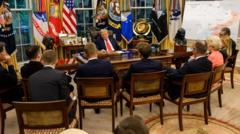Jimmy Carter’s solar initiative remains a significant moment in renewable energy history, displaying his forward-thinking legacy.
What Happened to Jimmy Carter’s Iconic Solar Panels?

What Happened to Jimmy Carter’s Iconic Solar Panels?
The journey of the first White House solar panels from installation to their eventual dispersal across continents.
In 1979, President Jimmy Carter made waves in the renewable energy movement by installing 32 solar panels on the roof of the White House. This decision came during a time of heightened energy crisis in America, exacerbated by the Arab oil embargo that had jolted the U.S. economy. Carter advocated for energy independence, stating the sun is a resource impervious to embargoes, reflecting his visionary approach to sustainable energy.
After just seven years, in 1986, the panels were removed by the Reagan administration during roofing renovations and were never reinstalled. Yet, the story of these panels did not end there. They were sold inexpensively to Unity College in Maine, where they continued to generate power for a significant time. Over the years, the solar panels migrated to various locations across the United States and even reached destinations in China.
Jimmy Carter's initiative was ahead of its time, as recognized by Ernest Moniz, a former energy secretary, who pointed out the former president's foresight regarding climate issues. It wasn’t until a decade later that Congress held its first hearing on climate change, cementing Carter’s status as a pioneer in addressing renewable energy.
While the physical panels may have been removed from their prominent placement atop the White House, their legacy of promoting solar energy and sustainability continues to resonate, highlighting a commitment to a future of renewable resources.
After just seven years, in 1986, the panels were removed by the Reagan administration during roofing renovations and were never reinstalled. Yet, the story of these panels did not end there. They were sold inexpensively to Unity College in Maine, where they continued to generate power for a significant time. Over the years, the solar panels migrated to various locations across the United States and even reached destinations in China.
Jimmy Carter's initiative was ahead of its time, as recognized by Ernest Moniz, a former energy secretary, who pointed out the former president's foresight regarding climate issues. It wasn’t until a decade later that Congress held its first hearing on climate change, cementing Carter’s status as a pioneer in addressing renewable energy.
While the physical panels may have been removed from their prominent placement atop the White House, their legacy of promoting solar energy and sustainability continues to resonate, highlighting a commitment to a future of renewable resources.



















